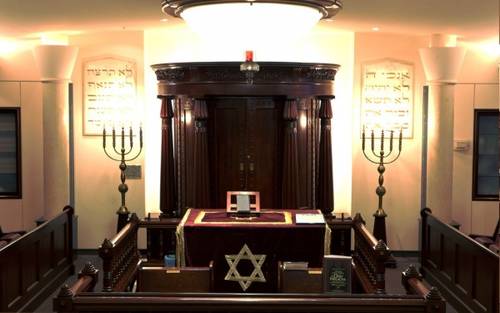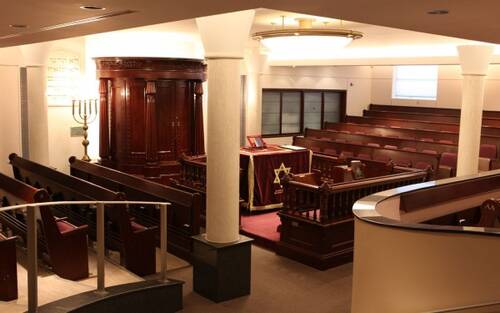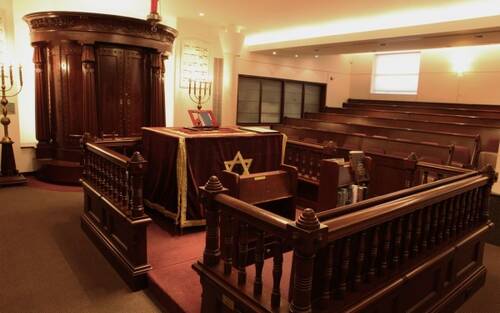-
CHABBAT EMOR / 20 IYYAR 5778/ 5 MAI 2018
Pour réserver une Aliya ou commanditer un Kiddoush
Nous avons reçu un don de $ 750.00 de la Banque T.D. par l’intermédiaire de Mayer Sasson; Un bon exemple à donner aux membres qui ont de bonnes relations avec la banque laquelle ils font affaire .Dernièrement nos recettes sont plutôt pauvres; Tout don serait fortement apprécié. Pour faire un don en ligne, ouvrez www.maghenabraham.com, donate. Merci
Cette semaine, la Synagogue Spanish and Portuguese célèbre ses 250 ans. Première Synagogue à Montréal, elle a reçu des immigrants de toutes les parties du monde . Plusieurs membres de Maghen Abraham se sont joints à la Spanish à leur arrivée à Montréal, Depuis 1983, Maghen réside dans l’enceinte de la Spanish et nos deux communautés vivent ensemble avec respect et harmonie. Nous souhaitons à La Spanish un avenir prospère et plein de succès, et qu’elle demeure le symbole de la fraternité et la diversité , toujours prestigieuse et honorée.
EMOR- en bref
« Parle aux pontifes, fils d’Aharon et dis-leur
La paracha de Emor (« Parle ») commence par l’énoncé des lois concernant les Cohanim (les « prêtres »), le Cohen Gadol (le « Grand-Prêtre ») et le service du Temple : un Cohen ne doit pas se rendre rituellement impur par le contact avec un cadavre, si ce n’est lors de la mort d’un parent proche. Il ne peut épouser une femme divorcée ou qui s’est déshonorée par la débauche. Le Cohen Gadol ne peut épouser qu’une femme vierge. Un Cohen atteint d'une difformité physique ne peut effectuer de service dans le Temple, de même qu’un animal atteint d’une malformation ne peut y être offert.
Un veau, un agneau ou un chevreau nouveau-né doit être laissé avec sa mère pendant sept jours. Il est interdit d’abattre un animal et sa progéniture le même jour.
La paracha énumère ensuite les Convocations Saintes, les fêtes du calendrier juif : le Chabbat hebdomadaire, le sacrifice pascal le 14 du mois de Nissan vers le soir et les sept jours de la fête de Pâque (Pessa’h) commençant le 15 Nissan. L’offrande du Omer sur les prémices de la moisson d’orge a lieu au second jour de la fête de Pâque à partir duquel, pendant quarante-neuf jours, a lieu le compte du Omer qui aboutit à la fête de Chavouot, le cinquantième jour. « Une commémoration de sonnerie de Choffar » a lieu le premier Tichri (Roch Hachana) ; le 10 Tichri un jour de jeûne solennel (Yom Kippour) ; la fête de Souccot pendant laquelle, à partir du 15 Tichri, on réside dans des cabanes et l’on prend les « quatre espèces » (palmier, myrte, saule et cédrat), suivie immédiatement par la fête du « huitième jour » de Souccot (Chémini Atséret).
La Torah évoque ensuite l’allumage de la Ménorah du Temple et le pain de proposition (Lé’hem Hapanim) placé chaque semaine sur la table du sanctuaire.
Emor se termine par l’incident lors duquel un homme fut exécuté pour blasphème et l’énoncé des peines applicables en cas de meurtre (la mort) et de blessure à son prochain ou dégradation de sa propriété (compensation financière). (Chabad.org/fr)
.
-
-
YOM YERUSHALAYIM – 28 IYYAR / 13 MAI 2018
God gave Adam and Eve the tools they needed to do their work ― minds to think and understand, and laws to teach them the difference between good and evil. He divided the world into seventy nations, each with a land of its own, and He gave them the Seven Noahide Commandments so they would know how to live. But it was hard for the people to keep even seven commandments, so God chose one nation ― the Children of Israel ― to keep the light of holiness alive in the world. He gave them His Torah with its 613 commandments, and He gave them the Land of Israel as an eternal inheritance.
He commanded the people to build him a Beit Hamikdash ― a House of God. Even though God does not live in a house, His Divine Spirit would always be in this one particular place. His house was to be built on the very spot where the Creation of the world had begun. It was the center of the world ― the Land of Israel. It was in the center of Israel, in the Holy City of Jerusalem. And it was in the very center of Jerusalem, on Har Habayit ― the Temple Mount. Of course there's no way we can measure the universe to see where the exact center is, but the Torah tells us that in some mystical way that our physical senses are unable to fathom, Har Habayit is the very heart of the world, the point where God first began the work of Creation.
In olden times, people knew this was not just another mountain top. They knew it was a holy place, connected to other dimensions, fused with the Spirit of God. Adam, the first man, brought an offering to God on this mountain. After the Great Flood, Noah brought a thanksgiving offering to the same spot. And it was here that Abraham brought his son Isaac as an offering, believing this was God's will. These things all happened long before the city of Jerusalem and the Temple were built, but they happened here, on Har Hamoriya, Mount Moriah, on Har Habayit, the Temple Mount.
From the moment King David built the city, Jerusalem was recognized as a place of worldwide importance. David made the arrangements and preparations to build the Temple, but it was his son Solomon who did the actual work. Cedar trees and olive wood, costly stones, brass and gold and silver were brought from countries far and near to build God's House.
"Behold," said Solomon, "if all the heavens and earth cannot contain the Glory of God, how can this house contain Thee?" But the Clouds of Glory filled the Temple as a sign that the Shechina, the Spirit of God, was indeed there.
The Beit Hamikdkash was like a window or a door to Heaven, a gateway where prayers would ascend directly to God. Not only would the prayers of the Jewish people be heard, but all people could come to the Temple to pray and all of God's blessings to the world would somehow flow from the Heavens above to the Earth below through this one, blessed spot where Creation had begun. From every country, people came to the Beit Hamikdash and Jerusalem became a Holy City for the entire world.
Solomon's Beit Hamikdash stood for 410 years. It was destroyed by the Babylonians in 423 BCE, 2425 years ago. Seventy years later, the Jews rebuilt the Temple. The Second Temple stood for 420 years; it was destroyed by the Romans in the year 68 CE. For the past 1934 years, Jews continued to live in Jerusalem, but always under foreign rule. Since then, we have directed our prayers to the Western Wall ― the Kotel Hamaaravi ― the one remaining wall which stood around the Temple Mount.
In 1967, on the 28th day of the month of Iyar, in the year 5727 (June 5, 1967), on the third day of the Six Day War, the ancient city of Jerusalem ― the walled Old City, the Temple Mount and the Western Wall ― returned to Jewish hands. For the first time since the Destruction of the Second Temple, Jerusalem was under Jewish sovereignty.
The ancient city of Jerusalem grew around the Temple. The modern city of Jerusalem continues to grow and expand far beyond the old walls, full of children and playgrounds, humming with traffic, brimming with synagogues, schools, stores, industrial centers, museums, offices, and government buildings. It is still surrounded by round hills, clothed in bright white morning light or rosy, golden afternoon rays. It still sits like a crown atop the Judean Mountains, calling to the Children of Israel... "Bo'ee Kallah, Come my Bride, back home to your Land, your Holy City, the House of God."
-
QUESTIONS AND ANSWERS – (OHR SOMAYAH)
All references are to the verses and Rashi's commentary, unless otherwise stated
- Which male descendants of Aharon are exempt from the prohibition against contacting a dead body?
21:1 - Challalim - those disqualified from the priesthood because they are descended from a relationship forbidden to a kohen.
- Does a kohen have an option regarding becoming ritually defiled when his unmarried sister passes away?
21:3 - No, he is required to do so.
- How does one honor a kohen?
21:8 - He is first in all matters of holiness. For example, a kohen reads from the Torah first, and is usually the one to lead the blessings before and after meals.
- How does the Torah restrict the Kohen Gadol with regard to mourning?
21:10-12 - He may not allow his hair to grow long, nor attend to his close relatives if they die, nor accompany a funeral procession.
- What is the smallest piece of a corpse that is able to transmit tumah?
22:5 - A piece the size of an olive.
- Who in the household of a kohen may eat terumah?
22:11 - He, his wife, his sons, his unmarried daughters and his non-Jewish slaves.
- If the daughter of a kohen marries a "zar" she may no longer eat terumah. What is a zar?
22:12 - A non-kohen.
- What is the difference between a neder and a nedavah?
22:18 - A neder is an obligation upon a person; a nedavah is an obligation placed upon an object.
- May a person slaughter an animal and its father on the same day?
22:28 - Yes. The Torah only prohibits slaughtering an animal and its mother on the same day.
-
10. How does the Torah define "profaning" the Name of G-d?
22:32 - Willfully transgressing the commandments.
11. Apart from Shabbos, how many days are there during the year about which the Torah says that work is forbidden?
23:7-36 - Seven.
12. How big is an omer?
23:10 - One tenth of an eipha.
13. .
14. H ow does the omer differ from other minchah offerings?
23:16 - It was made from barley.
15. The blowing of the shofar on Rosh Hashanah is called a "zichron teruah" (sound of remembrance). For what is it a reminder?
23:24 - The akeidas (binding of) Yitzchak.
16. What is unusual about the wood of the esrog tree?
23:40 - It has the same taste as the fruit.
PROVERBES DU TALMOUD ET PIRKÉ AVOT
Sois patient lorsque tu juges quelqu'un, et ne te hâte pas de le condamner.
Sois la queue des lions et non la tête des renards.
Jette un bâton en l'air, il retombera à la même place.
Ne juge pas ton prochain avant de te trouver à sa place.
.
Si ton épouse est petite, penche-toi vers elle.
Il n'est pas de livre plus fermé que cœur d'une femme.
Une amitié qui a pu vieillir ne doit pas mourir.
Demande un conseil à ton ennemi, et fais le contraire.
Le doute gâte la foi, comme le sel gâte le miel.
Que nul ne boive de telle coupe en portant les yeux sur telle autre.
-
THE SHABBAT SMILE:
A man is laying on the operating table, about to be
operated on by his son, the surgeon.
The father says, "Son, think of it this way ... If anything
happens to me, your mother is coming to live with you."
-------------------------------------------------
- all the instant messaging and texting lingo going around - with abbreviations like "LOL" and "OMG" and "BTW" - I asked a young lady named Karen if she would be going to shul this Shabbat, and with whom ,and she replied to me "JFK."
"JFK? What does that mean?", I asked. She answered : Just for Kiddush
-
-----------------------------------------------------
Pacing back and forth, a man was getting really anxios about his imminent operation.
His wife asked him: "What's the matter? Why are you getting so worked up?"
He replied: "I heard one of the nurses say 'It's a very simple operation, don't worry, I'm sure you'll be all right.'"
"She was just trying to comfort you," said his wife. "What's so frightening about that?"
"She was talking to the surgeon
-----------------------------------------------------------------
CHABBAT CHALOM
MAGHEN ABRAHAM
David Hasson




